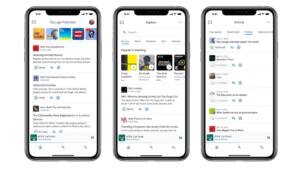Virtual Reality refers to a simulated experience that can be similar to or completely different from the real world. VR technology typically involves wearing a head-mounted display that immerses users in a computer-generated environment, often accompanied by motion tracking and interactive controllers.
VR technology has made significant strides in recent years, with improved graphics, increased affordability, and a broader range of content. This has led to a surge in popularity and adoption of VR across various sectors, including gaming, entertainment, education, and training. One new notable headset is the Meta Quest 3 by Meta
Augmented Reality overlays digital content onto the real world, enhancing users’ perception and interaction with their environment. AR experiences are typically accessed through mobile devices or smart glasses, allowing users to see and interact with virtual objects in real-time.
AR has found applications in fields such as advertising, retail, healthcare, and tourism. For instance, AR allows customers to try on virtual clothing or visualize furniture in their homes before making a purchase.
What is Mixed Reality?
Most recently, Apple released their Vision Pro which is ‘Mixed Reality’, or a combination of both VR and AR. Apple’s Vision Pro mixed reality headset presents exciting opportunities for sponsorships and content creators. With its ability to transform any room into a personal theater and provide stunning visuals, content creators can deliver immersive and engaging experiences to their audiences.
The 3D camera feature allows creators to capture spatial photos and videos, offering a new level of storytelling and enhancing the sponsored content they produce. The collaborative capabilities, such as life-size FaceTime calls and app-based collaboration, enable content creators to connect and collaborate with sponsors and colleagues in a more immersive and interactive way.
Additionally, the visionOS spatial operating system empowers creators to develop innovative apps that fill the space around users, providing unique sponsorship opportunities that extend beyond traditional screens.
The customizable environments and EyeSight feature also enhance brand integration possibilities, allowing sponsors to create branded virtual landscapes and ensuring that content creators remain connected with their audience while using the headset.
The Vision Pro headset may open up new avenues for sponsorships and will enable content creators to deliver captivating and immersive sponsored content experiences to their viewers.
The potential of VR and AR as platforms for content creation and consumption
VR and AR offer unprecedented opportunities for content creators to craft immersive and interactive experiences. Users can engage with content on a more personal and engaging level, enabling new forms of storytelling, gaming, and education.
Content creators in VR and AR must adapt their storytelling techniques to leverage the immersive nature of these technologies. They face challenges such as developing engaging narratives, designing intuitive interactions, and ensuring compatibility with various VR and AR platforms.
Sponsorships involve brands collaborating with content creators to promote their products or services. In the digital landscape, sponsorships provide a means for brands to reach targeted audiences through authentic and engaging content.
Sponsorships offer content creators financial support and resources to create high-quality content. Brands benefit from increased brand visibility, access to the creator’s dedicated fan base, and the opportunity to align their products or services with relevant content.
VR and AR provide a unique canvas for brands to create memorable and interactive experiences that seamlessly integrate their products or services.
Monetization Models for VR and AR Content Creators
Creating premium content and offering subscription-based access: Content creators in the VR and AR space can cater to their dedicated audience by creating premium content and offering subscription-based access. This model allows creators to offer exclusive and high-quality experiences that are only available to subscribers.
By providing access to a range of immersive experiences, such as advanced levels, special events, or unique storylines, content creators can offer added value to their most loyal fans.
Subscribers gain the benefit of experiencing content that goes beyond what is available to the general public, creating a sense of exclusivity and reward for their support.
Building communities and offering additional perks to subscribers: Subscription-based models not only provide access to premium content but also allow content creators to build communities and offer additional perks to subscribers. These perks can include early access to new releases or updates, behind-the-scenes content that provides insights into the creative process, or exclusive merchandise tied to the VR or AR experience.
By offering these additional benefits, content creators can foster a sense of belonging and engagement within their subscriber community. Subscribers feel a closer connection to the creator and fellow subscribers, creating a space for interaction, discussions, and shared experiences.
This sense of community can be further strengthened through exclusive events, Q&A sessions, or even virtual meet-ups, where subscribers can directly engage with the content creator and each other.
Subscription-based models provide content creators with a more sustainable and consistent revenue stream compared to one-time purchases or ad-based models. They allow creators to focus on creating high-quality content without being solely dependent on sponsorships or ad revenue.
By offering premium content and additional perks to subscribers, content creators can reward their most dedicated fans and cultivate a loyal and supportive community. Subscribers, in turn, receive enhanced access and benefits, along with the satisfaction of directly supporting the creators they admire.
The subscription-based model not only offers financial stability but also promotes a sense of belonging, exclusivity, and shared experiences. It allows content creators to continuously innovate and produce captivating VR and AR content, knowing they have a dedicated audience willing to support their creative endeavors.
The subscription model encourages ongoing engagement and relationship-building between creators and subscribers, fostering a mutually beneficial connection that drives the growth and sustainability of the VR and AR ecosystem.
In-App Purchases and Microtransactions
Integrating virtual goods and in-app purchases within VR and AR experiences: Content creators have the opportunity to monetize their creations by integrating virtual goods and in-app purchases within VR and AR experiences. These virtual goods can include items such as digital accessories, clothing, furniture, or even virtual currency that users can acquire and use within the virtual environment.
By offering these virtual goods for purchase, content creators can create additional revenue streams while enhancing the user experience. Users can customize their avatars or virtual spaces, unlocking new possibilities and personalizing their VR or AR experiences.
The availability of virtual goods adds value and extends the longevity of the virtual world, allowing users to engage and invest in the content on a deeper level.
Implementing microtransactions for enhanced user experiences: Microtransactions play a significant role in enhancing user experiences within VR and AR. They provide users with the opportunity to make small purchases within the virtual environment to enhance customization options, unlock additional features, or access premium content.
For example, users may have the option to purchase virtual upgrades, power-ups, or cosmetic enhancements that enhance their abilities or visual appearance within a game or virtual experience. These microtransactions can be an effective way for content creators to generate revenue while giving users the flexibility to tailor their experiences according to their preferences.
By offering these microtransactions, content creators can create a sustainable business model that allows for continuous updates and improvements to the VR or AR experience, keeping users engaged and invested in the content.
The integration of virtual goods and microtransactions provides benefits for both content creators and users. Content creators can generate revenue beyond traditional sponsorship models, allowing for ongoing development and support of VR and AR experiences.
Additionally, the availability of virtual goods and microtransactions allows for a more personalized and tailored experience for users, enabling them to enhance and customize their virtual presence or access premium content that adds value to their overall experience.
Advertisements and Sponsorships
Displaying non-intrusive advertisements within VR and AR experiences: Content creators in the VR and AR space have the opportunity to incorporate non-intrusive advertisements into the virtual environment, allowing them to generate revenue while maintaining a seamless user experience.
These advertisements can take the form of billboards, product placements, or other creative integrations that blend naturally with the virtual surroundings. By strategically placing these ads within the virtual or augmented reality environment, content creators can generate additional revenue streams without disrupting the immersive experience for users.
This approach ensures that advertisements are non-intrusive, relevant, and add value to the overall virtual experience.
Collaborating with brands for sponsored content and experiences: Sponsored content presents content creators with a valuable opportunity to collaborate with brands and deliver branded experiences that align with the virtual or augmented reality environment.
By partnering with brands, content creators can create unique and engaging experiences that integrate the brand’s products or messages seamlessly within the virtual world.
This collaboration not only provides content creators with an additional revenue stream but also allows brands to connect with audiences in an immersive and innovative way.
Whether it’s a virtual event sponsored by a brand, a branded virtual space, or a custom VR or AR experience developed in collaboration with a brand, these partnerships create exciting opportunities for both content creators and brands to reach and engage with their target audience.
Responsible Integration of Sponsorships in VR and AR: Maintaining the integrity of immersive experiences: Content creators must strike a delicate balance between incorporating sponsorships and preserving the immersive and authentic nature of VR and AR experiences. It is essential to ensure that sponsored content seamlessly integrates into the virtual or augmented reality environment without overwhelming or disrupting the user’s engagement.
The key is to approach sponsorships with a focus on enhancing the user experience rather than commercializing it excessively. By carefully selecting and thoughtfully integrating sponsorships, content creators can maintain the integrity of immersive experiences, allowing users to remain fully engaged and immersed in the virtual world while still being exposed to branded content.
Striking a balance between sponsored content and user experience: Content creators need to strike a balance between delivering sponsored content and maintaining a high-quality user experience in VR and AR.
While sponsorships can provide financial support and opportunities for content creators, it’s crucial not to prioritize commercial interests at the expense of user satisfaction. Content creators must carefully curate the sponsored content and ensure it aligns with the interests and expectations of their audience.
By delivering valuable and engaging sponsored experiences that enhance rather than disrupt the user experience, content creators can maintain the trust, loyalty, and interest of their audience.
Transparency and disclosure of sponsorships: Maintaining transparency is essential in the VR and AR space. Content creators should be upfront and transparent about their partnerships and sponsorships to maintain trust and authenticity with their audiences.
Clear and visible disclosures of sponsored content help to foster transparency and build credibility. By openly disclosing their partnerships, content creators demonstrate their commitment to their audience’s trust and ensure that sponsored content is perceived as genuine and authentic.
Targeting the right audience and aligning with the creator’s niche
Selecting sponsorships that align with the content creator’s niche and audience interests: When it comes to VR and AR sponsorships, it is crucial for brands to collaborate with content creators whose niches and audience interests align with their target market.
By selecting content creators who already cater to a specific demographic or have established themselves in a particular niche, brands can ensure a higher level of engagement and relevance for their sponsored content. When the sponsored content seamlessly integrates with the content creator’s usual topics or themes, it resonates better with the audience, leading to higher levels of interest and interaction.
This alignment of interests creates a win-win situation for both the brand and the content creator, as it fosters an authentic and meaningful connection with the audience, enhancing the effectiveness of the sponsorship.
Incorporating sponsorships seamlessly within the VR and AR experience: To create a positive and immersive user experience, sponsors should strive for natural integration of their brand or products within the VR or AR environment.
This means going beyond mere product placement and finding creative ways to seamlessly incorporate the sponsor’s offerings within the virtual or augmented reality experience.
Whether it’s a virtual product demonstration, an interactive branded environment, or a virtual event sponsored by a company, the integration should feel organic and enhance the overall user experience.
By integrating sponsorships seamlessly, brands can avoid disrupting the immersive nature of VR and AR experiences. The goal is to make the sponsorship feel like a natural part of the virtual world, rather than an intrusive advertisement. This approach allows users to engage with the brand in a more authentic and enjoyable manner, without feeling overwhelmed by commercial messaging.
When sponsorships are seamlessly integrated, they can create positive associations between the brand and the immersive experience, fostering a sense of trust and affinity among users.
More importantly, the seamless integration of sponsorships within VR and AR experiences enhances the credibility of both the content creator and the brand. When the sponsorship is well-integrated and does not feel forced, it adds value to the overall experience and enhances the perception of the content creator’s authenticity and expertise.
Users are more likely to embrace and appreciate the sponsored content when it enhances their virtual or augmented reality journey, leading to a stronger brand-consumer connection.
Measuring the effectiveness of VR and AR sponsorships
Utilizing analytics and data to assess the impact of sponsorships: In the realm of virtual and augmented reality, it becomes essential for brands and content creators to leverage analytics tools to evaluate the effectiveness of their sponsorships.
These analytics tools can provide valuable insights into various metrics, such as user engagement, reach, and conversion rates. By analyzing these metrics, brands can gauge the impact of their VR and AR sponsorships and make data-driven decisions regarding future campaigns.
Understanding the level of user interaction, the duration of engagement, and the overall reach of sponsored content allows brands to assess the return on investment and make informed choices about their sponsorship strategies.
Iterating and refining sponsorship strategies based on data insights: Data insights derived from analytics provide invaluable information for refining and optimizing sponsorship strategies. By continuously monitoring and analyzing data, brands and content creators can identify patterns, trends, and areas for improvement.
These insights help in understanding the preferences and behaviors of the target audience, enabling them to tailor future sponsorships to align better with user interests. Content creators can also use data to assess the performance of different sponsorship formats, placements, or collaborations with specific brands.
This iterative approach allows for the refinement of sponsorship strategies over time, maximizing the value and impact of future VR and AR sponsorships.
The use of data-driven insights not only benefits brands but also content creators. By analyzing data, content creators can gain a deeper understanding of their audience’s preferences and the effectiveness of different sponsorship collaborations.
They can identify which types of content resonate the most with their audience and make informed decisions about future partnerships. This data-driven approach empowers content creators to create more compelling and relevant sponsored experiences, enhancing their credibility and attracting more sponsorship opportunities.
Data insights facilitate collaboration between brands and content creators. By sharing analytics data, both parties can evaluate the success of a sponsorship and work together to refine the strategy for better results.
This collaborative approach allows for a more productive and mutually beneficial partnership, where brands can fine-tune their messaging and content creators can enhance their sponsored content to align with the brand’s goals.
The Future of Sponsorships in VR and AR
Advancements in VR and AR hardware and software: As virtual reality (VR) and augmented reality (AR) technologies continue to advance, the hardware and software capabilities are constantly improving. This progress opens up new possibilities for innovative sponsorships within the VR and AR space.
Higher-resolution displays, more realistic graphics, improved tracking systems, and enhanced sensory feedback contribute to a more immersive and engaging user experience.
Content creators and brands can leverage these advancements to create sponsorships that take full advantage of the cutting-edge hardware and software, offering users unique and captivating experiences.
Integration of AI and personalized experiences: Artificial intelligence (AI) plays a significant role in enhancing VR and AR experiences. By leveraging AI algorithms, VR and AR platforms can gather user data and provide personalized content recommendations.
This integration enables targeted sponsorships tailored to the individual preferences and interests of users. Brands can leverage AI-driven insights to deliver customized sponsored content that resonates with each user, maximizing engagement and impact.
AI can analyze user behavior, preferences, and demographics to optimize sponsorships and ensure they align with the user’s interests, creating a more immersive and personalized experience.
User-generated content as a sponsorship opportunity: VR and AR platforms often provide users with tools to create and share their own virtual worlds and experiences. This user-generated content (UGC) opens up unique sponsorship opportunities for brands.
Content creators can collaborate with brands to integrate sponsored elements within the user-generated virtual environments. This approach allows brands to tap into the creativity and enthusiasm of the user community and reach audiences in an authentic and engaging way.
By sponsoring user-generated content, brands can connect with users on a more personal level, fostering a sense of community and co-creation.
Social interactions and shared experiences: One of the most compelling aspects of VR and AR is the ability to facilitate social interactions and shared experiences. Users can engage with sponsored content together, participate in multiplayer games, and explore virtual environments with friends and acquaintances.
This social dimension of VR and AR experiences provides a unique opportunity for sponsorships. Brands can create immersive and interactive experiences that encourage users to share their sponsored moments with others. By enabling social interactions and shared experiences, brands can amplify the reach and impact of their sponsorships.
The collective memories created through shared VR and AR experiences can strengthen brand awareness and deepen user engagement.
Ethical considerations and responsible sponsorships
Ensuring privacy and data security: As VR and AR platforms collect user data, responsible sponsorships require strict adherence to privacy regulations and data security measures.
Promoting inclusivity and diversity in sponsorships: Brands and content creators should prioritize inclusive and diverse representations within VR and AR experiences to foster a sense of belonging and reach broader audiences.
Transparency in sponsored content and disclosures: One of the key considerations in integrating sponsorships into virtual and augmented reality experiences is maintaining transparency. Content creators should clearly disclose when they are engaging in sponsored content to ensure transparency and build trust with their audience.
This can be achieved by incorporating visible branding or logos within the virtual environment or explicitly mentioning the sponsorship during the experience. By being transparent about sponsored content, creators maintain authenticity and credibility, which enhances the overall immersive experience for users.
Respecting user privacy and data protection: As virtual and augmented reality experiences become more immersive, it is crucial to prioritize user privacy and data protection. Content creators should ensure that any data collected during the sponsored experiences is handled responsibly and in compliance with privacy regulations.
They should inform users about the data collection practices and obtain necessary consent. By respecting user privacy, content creators can foster a sense of trust and create a safe environment for users to engage with sponsored content.
Ensuring that sponsorships align with the creator’s values and audience interests: Successful sponsorships in virtual and augmented reality rely on the alignment between the creator’s values, the audience’s interests, and the brand’s objectives.
Content creators should carefully consider sponsorships that resonate with their audience and fit seamlessly into the immersive experience. By partnering with sponsors whose values align with their own and their audience’s, creators can ensure that sponsored content feels authentic and enhances the overall user experience.
Avoiding excessive commercialization that may hinder the immersive experience: While sponsorships offer opportunities for monetization, it is essential to strike a balance and avoid excessive commercialization that may disrupt the immersive experience.
Content creators should carefully integrate sponsored elements in a way that doesn’t detract from the overall immersion or compromise the quality of the content.
Balancing commercial interests with user experience ensures that sponsored content enhances rather than detracts from the immersive environment, resulting in a more enjoyable and engaging experience for users.
Virtual and augmented reality are poised to transform the way content is created, consumed, and monetized. Sponsorships in VR and AR open up new opportunities for content creators to generate revenue while delivering engaging experiences to their audiences.
By embracing sponsorships responsibly, creators can forge meaningful partnerships with brands, fueling the growth of this exciting medium. As VR and AR continue to evolve, the future holds immense potential for innovative sponsorships that blur the line between the digital and physical worlds.




